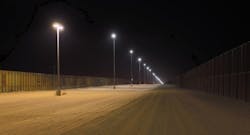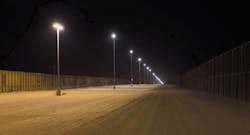The Yuma border fence SSL trial in the Arizona desert will be a story that ends without a comprehensive conclusion, although LED-based lighting did prove superior to legacy sources in the high-temperature harsh environment.
The US Department of Energy (DOE) has released the final report in its Gateway installation of outdoor LED lighting along a section of the US/Mexico border fence near Yuma, AZ. Neither the DOE researchers from the Pacific Northwest National Laboratory (PNNL) nor Eaton’s technical team (involved as the commercial partner on the project) have been able to identify exactly why the first products tested suffered unexpected levels of lumen depreciation, although the desert heat remains a possible reason or contributing factor. But the lighting has still proven far more reliable than legacy sources and improved light quality has made the job of the Border Patrol much easier.
Interested in articles & announcements on LED lighting trials and R&D?
The DOE Gateway projects involve testing commercialized solid-state lighting (SSL) products in actual end-use cases to learn about how well the LED technology performs in specific applications and to gauge return on investment. The Yuma border Gateway project dates back to 2014 when the DOE first revealed that it had installed SSL along a section of the border fence in that area. That first article on the project discussed the installation and reported on the superior lighting that the move to LEDs afforded. But even then, the DOE said it also wanted to study the impact of high temperature over time.
In mid-2015, the DOE issued a second report after the luminaires operated for 5000 hours. At that time, the researchers found illuminance varied more than expected, but ultimately that change was shown to be due to the greater-than-expected dirt accumulation on the secondary optics. The project also included installing second-generation LED products along the fence for further testing.
In the latest, and said to be final, report on the project the DOE has again revealed some surprising results. The DOE tested the first-generation outdoor LED lighting at 7000 and 11,000 hours. After 11,000 hours, the researchers found unexpectedly that the luminaires, in a clean state, delivered only 50% illuminance relative to measurements when the lights were new.
In the conclusion of its outdoor LED lighting performance tests in Arizona desert conditions, the US Department of Energy has not been able to determine the exact causes of a decrease in illuminance at specified test duration points. (Photo credit: US DOE.)
The PNNL and partner Eaton have both tried to discern the precise cause without success. The new report notes that the luminaire design in question places the packaged LED with an integrated primary optic directly under a secondary optic and that contact between the two could cause some deformation, but apparently that could not have been responsible for the full reduction in illuminance. The report also speculates about heat and other environmental conditions specific to the desert site, and possibly factors specific to the luminaire design.
The DOE report reminds that while test standards such as LM-80 and lumen maintenance projections based on TM-21 are very valuable, they still do not tell the full story. LM-80 data for the LEDs in the impacted luminaires suggested that the sources would suffer less than 2% depreciation after operating for 10,000 hours at 105°C. Even luminaire testing in the laboratory may not reveal the same results as what may be found in actual installations, according to the DOE.
The second-generation luminaires, meanwhile, were tested after 4000 hours of operation in late 2017. Those products had lumen depreciation commensurate with what was expected from dirt depreciation. The luminaires had suffered from unexpected variation in color over angle that the DOE said was very noticeable on the surface of the desert sand. That color over angle issue was not present in the first-generation products. And color over angle may not be noticeable in a street or parking lot application, according to the DOE.
The second-generation luminaires were installed in 2016 as part of a large deployment that covers 7.2 miles of border fence and more than 400 luminaires. The results of the outdoor LED lighting project have been very positive as is explained in a video.
The Border Patrol had been accustomed to making repairs on as many as ten fixtures per month in that stretch of border fence with the legacy HID ballasts and lamps also struggling in the harsh conditions. The SSL installation has slashed the maintenance and energy costs.
Still, it’s quality of light and uniformity that may be more important. The legacy lights left dark spots along the base of the primary fence that allowed illegal crossers to hide, having breached the first fence, until a patrol vehicle passed by. In the video, the Border Patrol notes that patrols along the fence in vehicles can now clearly see the base of the wall. The initial link at the top of this story has a diagram that shows the configuration of the luminaires and two fences.
You can access all of the DOE reports on the Gateway project on the agency’s SSL website. There is also a brief summary on the newest report that includes the video.
*Updated May 23, 2018 12:50 PM for correction of operating hours.






